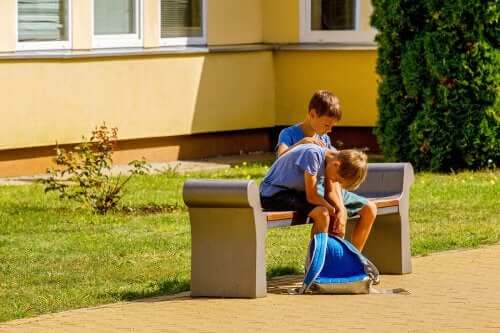How to Promote Empathy and Friendship in the Class

Fostering empathy and friendship in the classroom is essential in order to achieve good relationships and strong bonds among students. Teachers need to find the best tools to create this environment.
Empathy is a very important part of living in a community, and school is no exception to this; it is, after all, a type of community. People who are empathetic are generally more supportive. Also, academic success is easier to achieve if you’re able to understand others, help them, and work with them.
What does empathy really mean?
The word empathy is used a lot, but what does it really mean? To have empathy is to care about another person’s feelings. It involves thinking, feeling, and even having a physical reaction to what others feel when we relate to them.
Empathy makes it possible for friendships to emerge. To have empathy, we have to identify and understand other people’s feelings. In addition, we must care about these feelings and value them.
Resources for enhancing empathy and friendship in the classroom
Short films
We’re going to focus on some short films now and, if you show them to your class and get the children to comment on their content, then you’ll be promoting and working on empathy and friendship.

Mouse for Sale
A mouse is the main character in this story. Snickers is a mouse that feels rather lonely and, every day in the pet shop where he lives, he’s hoping for a child to appear and notice him. Since he has very big ears, the others always make fun of him. Then everything changes when a special child like him shows up at the shop – a child who really understands him.
Chicken or the Egg
In this video, we get to know a little piggy who loves to eat eggs. However, one day, everything changes when he falls in love with a chicken and knows he has a choice to make. In this story, we experience empathy with a good dose of humor with this unusual couple.
Empathy
This video is just over a minute in length. Music is the main focus of this simple animated story which shows us how we feel if we’re able to put ourselves in someone else’s shoes, and how important it is to do this.
Using stories to promote empathy and friendship
Another interesting resource to encourage empathy is to read stories to the children. It’s great to read them aloud and let the children comment on them.
Some examples we can use are:
Five Minutes of Peace – Jill Murphy (from age 3)
In this story, we see an elephant family having breakfast. Their mother needs some time for herself, and she prepares a hot bath and decides to have a bit of “me time.” The other elephants interrupt her, and the story that develops helps us to put ourselves in the place of others.

I’m the best – Lucy Cousins (from 3 years old)
Dog loves his friends very much, but he thinks he’s better than all of them. He even tells them why he thinks that. His friends feel very upset and get a bit fed up about it all. They decide to teach Dog a little lesson so that he can see that they’re good at lots of things too.
Using drama in the classroom
Drama is a powerful tool that we can use to work on and develop several social skills and values. It’s also one of the best ways to put ourselves in other people’s shoes. In our drama classes we can create small drama-based games to deal with conflicting issues in the group, and develop them together.
For example, we can take some sort of misunderstanding that has occurred in the classroom or the playground, maybe arguments the children have had, and create a small play where we’ll be able to see how other people feel or have felt.
So, we hope you’ve enjoyed our selection of activities to help work on empathy and friendship in class. This can always be done in a natural and fun way, and the students will gradually acquire these two values that are so important for their lives.
Fostering empathy and friendship in the classroom is essential in order to achieve good relationships and strong bonds among students. Teachers need to find the best tools to create this environment.
Empathy is a very important part of living in a community, and school is no exception to this; it is, after all, a type of community. People who are empathetic are generally more supportive. Also, academic success is easier to achieve if you’re able to understand others, help them, and work with them.
What does empathy really mean?
The word empathy is used a lot, but what does it really mean? To have empathy is to care about another person’s feelings. It involves thinking, feeling, and even having a physical reaction to what others feel when we relate to them.
Empathy makes it possible for friendships to emerge. To have empathy, we have to identify and understand other people’s feelings. In addition, we must care about these feelings and value them.
Resources for enhancing empathy and friendship in the classroom
Short films
We’re going to focus on some short films now and, if you show them to your class and get the children to comment on their content, then you’ll be promoting and working on empathy and friendship.

Mouse for Sale
A mouse is the main character in this story. Snickers is a mouse that feels rather lonely and, every day in the pet shop where he lives, he’s hoping for a child to appear and notice him. Since he has very big ears, the others always make fun of him. Then everything changes when a special child like him shows up at the shop – a child who really understands him.
Chicken or the Egg
In this video, we get to know a little piggy who loves to eat eggs. However, one day, everything changes when he falls in love with a chicken and knows he has a choice to make. In this story, we experience empathy with a good dose of humor with this unusual couple.
Empathy
This video is just over a minute in length. Music is the main focus of this simple animated story which shows us how we feel if we’re able to put ourselves in someone else’s shoes, and how important it is to do this.
Using stories to promote empathy and friendship
Another interesting resource to encourage empathy is to read stories to the children. It’s great to read them aloud and let the children comment on them.
Some examples we can use are:
Five Minutes of Peace – Jill Murphy (from age 3)
In this story, we see an elephant family having breakfast. Their mother needs some time for herself, and she prepares a hot bath and decides to have a bit of “me time.” The other elephants interrupt her, and the story that develops helps us to put ourselves in the place of others.

I’m the best – Lucy Cousins (from 3 years old)
Dog loves his friends very much, but he thinks he’s better than all of them. He even tells them why he thinks that. His friends feel very upset and get a bit fed up about it all. They decide to teach Dog a little lesson so that he can see that they’re good at lots of things too.
Using drama in the classroom
Drama is a powerful tool that we can use to work on and develop several social skills and values. It’s also one of the best ways to put ourselves in other people’s shoes. In our drama classes we can create small drama-based games to deal with conflicting issues in the group, and develop them together.
For example, we can take some sort of misunderstanding that has occurred in the classroom or the playground, maybe arguments the children have had, and create a small play where we’ll be able to see how other people feel or have felt.
So, we hope you’ve enjoyed our selection of activities to help work on empathy and friendship in class. This can always be done in a natural and fun way, and the students will gradually acquire these two values that are so important for their lives.
All cited sources were thoroughly reviewed by our team to ensure their quality, reliability, currency, and validity. The bibliography of this article was considered reliable and of academic or scientific accuracy.
- Jill Murphy. Cinco minutos de paz. Ed Kalandraka. 1986.
- Lucy Cousins. Soy el mejor. Ed. Parramón. 2010.
This text is provided for informational purposes only and does not replace consultation with a professional. If in doubt, consult your specialist.








